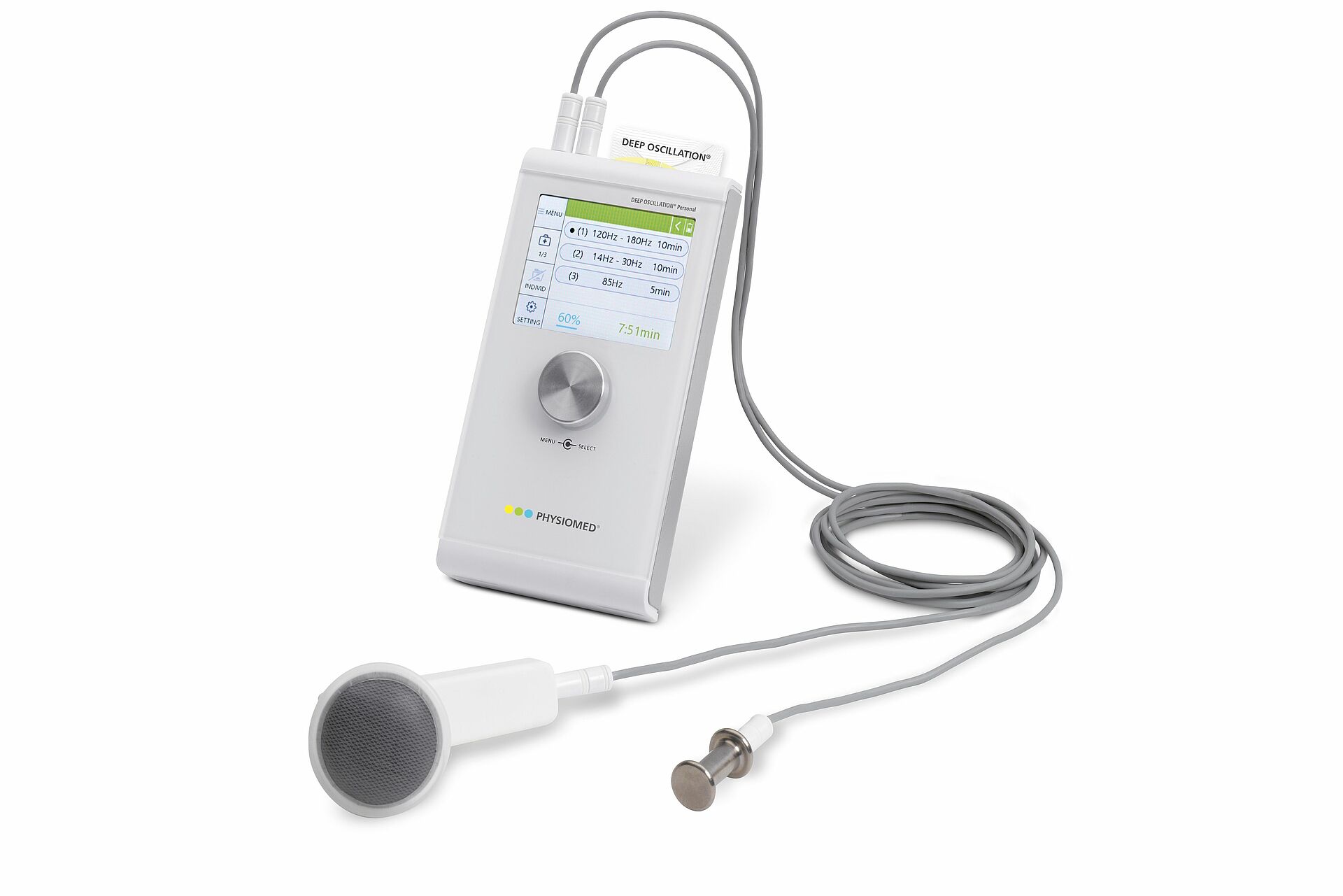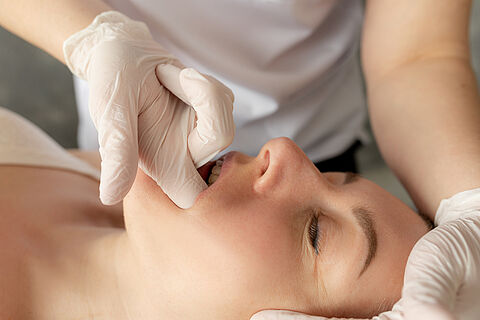DEEP OSCILLATION® Now Transforming Speech Therapy
From Practice for Practice: Experiences with DEEP OSCILLATION in speech therapy
Original Article Published on Proxomed®
Speech therapist Kerstin Müller specializes in treating people with severe head and neck injuries in her practice. For facial paralysis, voice and swallowing difficulties, or after laryngectomy, she also uses deep oscillation therapy with the DEEP OSCILLATION Personal Basic device. Learn how the expert uses the device, what her experiences with it have been, and what her patients say about it.

Kerstin Müller - Speech Therapist
Kerstin Müller has been familiar with the benefits of electrotherapy for decades: As the owner of sprachprax – a speech therapy practice in Bonn, she works with adults and children suffering from severe head and neck injuries, after laryngectomy, or with voice problems. Müller and her team have long used devices from the PHYSIOMED GROUP in their therapy. In 2024, the experienced speech therapist decided to also treat her patients with deep oscillation therapy. Unlike conventional methods, this therapy generates vibrations directly in the tissue. This promotes wound healing, improves metabolism and blood circulation, supports muscle relaxation, and improves mobility (you can read more about how deep oscillation works here ).
Facial palsy in focus
Kerstin Müller initially tested DEEP OSCILLATION on patients with facial palsy, who make up the majority of her clientele. "People were immediately enthusiastic about the deep oscillation, and I found it very easy to use," says the speech therapist. In people with facial palsy (paralysis of the facial muscles), the facial nerve is damaged, and this is usually accompanied by synkinesis . In this condition, the damaged nerve fibers involuntarily activate other muscles during movement. For example, blinking can cause the corners of the mouth to twitch, or the eye may close when opening the mouth. In contrast, hyperkinesia refers to excessive, involuntary movements that can occur in various neurological or psychological disorders. Both movement disorders can lead to muscle spasms.


In traditional speech therapy, therapists typically use heat, massage, and stretching as pretreatment. "We work a lot with our hands. When you've treated three or four faces a day, you really feel it in your fingers. Deep oscillation is much more relaxing, and I don't need heat treatment anymore," explains Müller. With deep oscillation pretreatment, both sides of the face can be effectively hyperemic and deeply loosened. "Afterwards, I can then – if necessary – do another stretch on the synkinetic side," says the speech therapist. "After just 20 minutes of deep oscillation plus 5 to 10 minutes of stretching, the cramps and pain are gone from the face, and the patients say they have two symmetrical sides again. It's truly amazing!" Furthermore, patients consistently report that they find the treatment very pleasant and relaxing, so they feel much better prepared for the subsequent mental and physical work.
Speaking calmly after laryngectomy
A patient reported severe shoulder and neck pain following a laryngectomy. Despite having a voice fistula, she was unable to produce any sound due to significantly increased muscle tone. Kerstin Müller treated the entire neck, floor of the mouth, and jaw area with deep oscillation, utilizing different frequencies and intensities. "Afterward, the woman was able to put on her sweater again without any problems, and the pain was gone," said the speech therapist. "Her overall muscle tone was so well regulated that she was able to redirect airflow and speak through her voice fistula during the same appointment—without hypertonia. And this has lasted for a long time."

 DEEP OSCILLATION Personal Basic – incredibly easy to use at home.
DEEP OSCILLATION Personal Basic – incredibly easy to use at home. Self-treatment for hyperkinesia
A plate in the cervical spine following a herniated disc led to restricted movement and increased muscle tone in the neck area for one patient, which negatively impacted her existing idiopathic facial palsy. Painkillers only provided short-term relief, but deep oscillation therapy offered the patient effective and lasting relief: "When I use deep oscillation therapy, first targeting the neck muscles and then moving through the anterior and lateral neck muscles to the face, the patient experiences pain relief and muscle relaxation in these areas for up to 24 hours after just one hour of treatment," reports Kerstin Müller.
Another advantage: With DEEP OSCILLATION, the woman can also treat herself. To improve the hyperkinesis in her face and live pain-free in the long term, she needs to regularly massage her face and stretch the muscles at home. However, this isn't possible with her hands due to osteoarthritis in the base joints of her thumbs. Therefore, the patient uses the DEEP OSCILLATION Personal Basic device with the accompanying hand applicators and is getting along very well with it.

Special vinyl gloves allow for precise tactile sensitivity.
Photo: iStock/Tatsiana Volkava
Kerstin Müller's team also enjoys using the applicators in their practice. She herself, however, prefers the special vinyl gloves: "With my hands and the special gloves, I can feel the tissue, muscles, and skin even better. I work with my hands and DEEP OSCILLATION just as I would without the device, only I don't have to press as hard. I practically glide over the skin."
Fast help for swallowing and jaw problems
In dysphagia therapy, Kerstin Müller and her team primarily use the DEEP OSCILLATION Personal Basic for hypertonicity in the suprahyoid muscles (upper hyoid muscles), which are usually involved in swallowing difficulties. Deep oscillation is also used for patients with voice disorders and jaw problems. The speech therapist recounts the story of a patient with severe hypertonicity in the larynx and jaw problems. She wears a bite guard at night and notices how hard she actually clenches her teeth when she wakes up in the morning. "After the first treatment, she told me that she woke up with her mouth open the next day," says Müller. "She's so enthusiastic about it that she's now taking the information with her to the rehabilitation clinic. She definitely wants to have it again."
After a year of intensive experience, DEEP OSCILLATION has established itself as an indispensable tool in Kerstin Müller's speech therapy practice: "I'm a huge fan of deep oscillation because it makes my work so much easier," she summarizes. The patients are also enthusiastic: "They come in, lie down on the couch, and say, 'Let's begin!' That's why I wouldn't want to be without the device in therapy anymore."

